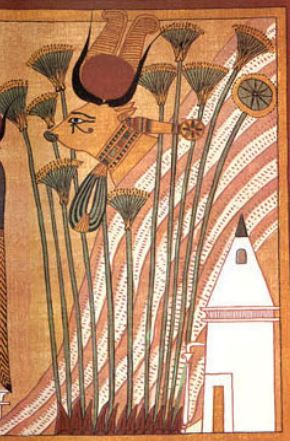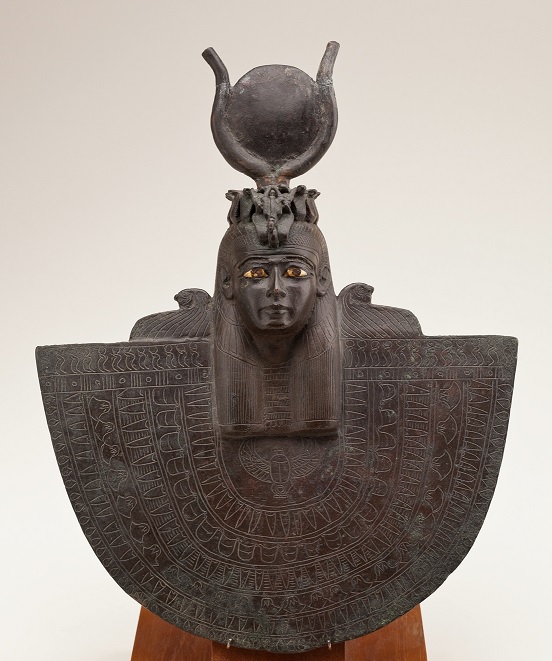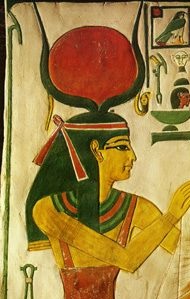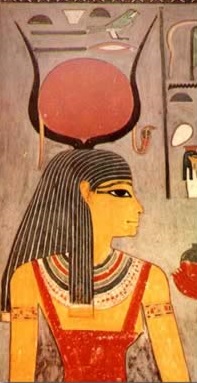Hathor, Isis, Ptah, Sokar, Atum
& the “Sun of the Night,” Atum-Ra
Gods of the Ecliptic and Celestial Equator
A growing picture of chaos…
Planetary chaos dominated the ancient world – the solar system was awash with water, dust, gasses and debris which was naturally drawn into the plane of the ecliptic (zodiacal plane). With the Sun at the centre and the dust spanning out beyond Pluto the solar system looked like a giant spinning top. The dust engulfed the planets forming gigantic equatorial ring systems around most including that of earth – analogous to Saturn’s rings today but on a far grander scale.

Edge on view of the solar enshrouded in dust and debris.
Combined with atmospheric dust, from an earthly perspective the effects were profound – the wall of dust some 93 million miles thick (distance between the Earth and the Sun) hazed the sun red exactly as portrayed by the Egyptians. Ancient cultures were presented with a permanent ‘red sun at sunset’ throughout the day, so to speak (and an even deeper red at sunset). This perennial state of no blinding, burning glare from the Sun god Ra allowed the Egyptian’s to undertake agricultural works and build great monuments wearing nothing more than a loincloth at any time during the day, indeed throughout the year.
The very same volatiles, dust and debris that hazed the Sun red granted visibility to the otherwise invisible. For example, the ecliptic today is an invisible path that the Sun and the planets trace across the sky. Similarly, the celestial equator is a projection of the terrestrial equator out into space – both invisible lines drawn on the celestial sphere. Not so in ancient times, both were seen and both featured prominently in Egyptian theology.
 Description of relations between Axial tilt (or Obliquity), rotation axis, plane of orbit, celestial equator and ecliptic. Earth is shown as viewed from the Sun; the orbit direction is counter-clockwise (to the left). Credit: Dennis Nilsson.
Description of relations between Axial tilt (or Obliquity), rotation axis, plane of orbit, celestial equator and ecliptic. Earth is shown as viewed from the Sun; the orbit direction is counter-clockwise (to the left). Credit: Dennis Nilsson.

The path of the ecliptic and celestial equator drawn on the celestial sphere.
The Goddess Hathor (Ninhursag) – Earth’s rings
Hathor (See GKS 2) was the goddesses of Earth’s ring of debris – an enormous band of dust and gasses that congregated around earth’s equatorial girth, or celestial equator. From an earthly perspective Hathor appeared as a cosmic band of debris arching across the heavens on an east-west axis – a thick hazy band of milk and honey – observed during the night, twilight hours and similarly during the day, although this would depend upon the intensity of chaos and just how bright Ra was allowed to shine (red Sun).

Hathor, the house of the red disk, Earth’s rings. The papyrus thicket signifies electrical sprites and elves.

A starry Hathor giving milk to personified astral bodies.
Hathor’s epithets and iconography are consistent with a hazy band of debris arching across the heavens. Most are self-explanatory.
• Lady of the Sky
• Daughter of Ra (Ra appeared many times amidst the thick hazy band of Hathor)
• The Mistress of Heaven
• Lady of the Stars
• Goddess of Love, Music and Beauty (an audible noise from the sky led to the Sistrum).
• Goddess of Fertility, Children and Childbirth
(Planetary Horus bodies, asteroids and comets perceived to be the kas (‘souls’) of humans were born to earth amidst Hathor, See GKS 1)
• The Mothers of Mothers, the Celestial Nurse (See GKS 2)
• The great wild cow (GKS 2)
• Goddess of the Dead, Lady of the West
(Hathor was seen to escort ‘deceased’ astral bodies to the west, in preparation for the arduous journey to the Egypt above (Upper Egypt).
• The mistress of life
• Mistress of Turquoise (main colour turquoise)
• The golden one (other times golden)
• Lady to the limit of the universe
• The powerful one
• The great one of many names (the numerous diverse aspects of earth’s rings)
An aspect of Hathor, the goddess Sekhmet (the more immediate fiery sky) was said to have created the sandy deserts with her breath. Something I take at face value as unfathomable quantities of sand rained down on earth to form the Sahara and Arabian deserts (see my latest book Extraterrestrial Sands).
The sweep of the ecliptic
From the perspective of Earth, the ecliptic sweeps out across the night sky also on an east-west axis – this is down to Earth’s axial tilt in respect to the ecliptic (23.4 degrees). Earth’s tilt has the effect of giving the ecliptic depth and dimension – of spanning out or being stretched out across the cosmos as opposed to appearing as a relatively thin band or line, which is what we would have if earth stood upright. Unfortunately the ecliptic sweep is virtually indiscernible to us today – the only time we gain a sense of its depth is during a planetary conjunction, a time when certain planets appear to line up in the sky. When this occurs, planetary bodies seem to take on the role of divine stepping stones to the firmament above (Upper Egypt), particularly if they line up behind the intermediary god Thoth (Moon).
Isis (Ast, Aset). Mistress of Magic – the sky!
“Praise to you, Isis, the Great One, God’s mother, Lady of Heaven, Mistress and Queen of the gods.” “Isis, giver of life, residing in the sacred mound.” (Isis temple, Philae)
With a flat earth in mind, located just beyond Hathor (earth’s rings) we have the domain of the goddess Isis – mother goddess and guardian of the ecliptic during the day, dusk and twilight. Isis was attributable to no physical planet (although in later times possible associated with the star Sirius or Venus) but the region of the sky from where many ‘magical’ things happened (a hive of activity would be an understatement).
 The great sky goddess Isis depicted with outstretched wings symbolic of the basic east-west path sweep of the ecliptic (Essentially the sky during the day)
The great sky goddess Isis depicted with outstretched wings symbolic of the basic east-west path sweep of the ecliptic (Essentially the sky during the day)
A broad region of the sky where errant Horus bodies (largely Mars, Mercury, Venus and the Moon) appeared to move back and forth to earth in a perennial cycle of death and rebirth. Planets would morph from a star (Osiris) to a living breathing red orb (Horus kings, in the image of Ra), reign over earth for a period of time, only to move away again, ‘mummifying’ back into an Osirian (star) once again. And, providing they passed the ‘good and just’ test of ma’at (weighing of the heart), they were ultimately rewarded with a life eternal in the Egypt above (Upper Egypt), or so it was believed. As you would expect, Isis, as the ecliptic haze played an important role in this process, many times seen escorting the deceased to the west and introducing them to god of the stars Osiris.
Planetary red orbs (Horus bodies) quite literally ruled ancient skies and they were clearly seen courtesy of a red sun. It is the very reason why the red disk dominates Egyptian art.
The birth and nurturing of Horus bodies amidst the general path taken by Ra was represented in iconic suckling scenes and statuettes.

Isis, seen here suckling the infant Horus. A theme that echoes throughout the ages e.g., Mary and Jesus, Madonna and child. The ecliptic Isis was quite literally, the seat or throne (her name denotes throne) of the celestial Horus kings.
Isis was revered as the great protector, prayed to for guidance, and beseeched for peace in the world. Her attributes and epithets were so numerous that she was called “the many-named,” “the thousand-named,” and in Greek inscriptions “the myriad-named.” As with Hathor these are virtually self-explanatory given my identification.
• The Great Lady
• Lady of Heaven
• Great Enchantress
• Goddess of Magic
• Goddess of Love and War
• Giver of Life
• Queen of the Gods
• Goddess of Marriage and Protection
• Opener of the Year
• Lady of the House of Fire
• Maker of the Sunrise
• Goddess of Countless Names
• Lady of the Great House
• From Whom all Beginnings Arose
• Brilliant One of the Sky

Aegis of Isis
Aegis of Isis: This once colourful necklace (replete with horns wrapped around the ‘Horus’ disk) derived from physical observations of the colourful dust that was seen to envelope planetary bodies including Ra. The Aegis was thus perceived to ‘house’ and protect them.
As Earth’s visible celestial equator, Hathor remained a virtually fixed feature. Isis on the other hand, although also maintaining a basic east-west axis, moved throughout the day and up and down the horizon throughout the seasons (following the Sun). Either way, they were both sky goddesses that physically crossed paths daily and annually – it could easily be said, they both inhabited the same basic region of the sky during the day. This is the very reason why, as bovine goddesses they carried similar epithets and were at times interchangeable. A situation clearly played out in the imagery. For example, the images below are of Isis and Hathor respectively – now, spot the difference? You can’t, the only way to tell them apart is by the accompanying hieroglyphs that identify them. A very important point when attempting to give physical presence to such pre-eminent deities.


Spot the difference!

The basic domain of the sky goddesses Hathor and Isis. Comet Venus amidst Hathor. Mars meanwhile nurtured by Isis.
The horizon: to the eye of the viewer a dense band of dust encircling earth that Ra & Horus bodies would appear “in” or “on.”
A rough idea of how the sky may have looked through Pharaonic times during the day. Bearing in mind there is a lot missing from this image. For example, Amun-Ra, the aurora of the day in not shown, and then there’s the perennial adversary to Ra, the jet stream otherwise known as Apep/Apophis. Please follow the links for more information of these.


